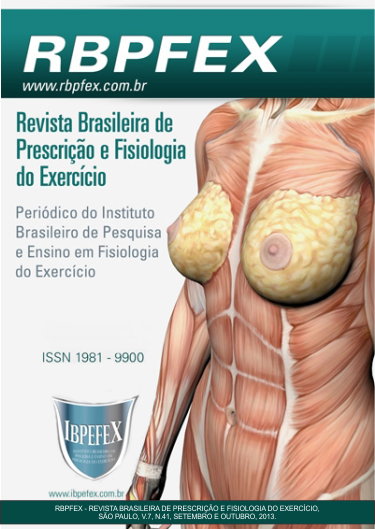Personal trainers' profile who works at Caçador/SC city
Abstract
The purpose of this paper was to outline the profile of Physical Education (PE) professionals who act as Personal Trainers (PT) in Caçador/SC. The study was carried out with 09 women and 17 men. A questionary with 13 questions related to personal data, academic degree, fitness evaluation, other professionals’ interaction, places where the services are provided, means of hiring the service and hourly fee, in and out of the fitness center was applied. The results have shown that 65.38% of the PT are men, 57.69% are under 30 years old and 57.69% are single. Related to the academic degree, 26.92% don’t have the academic qualifications demanded by the Regional Board of Physical Education, 30.77% have the college degree and 42.31% have a latu sensu major. All use the fitness evaluation, while 88.46% do that it person; 57.70% say they do that each other three months and 88.46% interact with other health fields. The fitness centers are the most used places to work (88.46%) and the verbal agreement is the most common way to hire the services. Concerning to the hourlyfee in a fitness center, 50% charge up to R$35.00, but, outside this room this fee can be over R$80.00. It is concluded that the PT are linked to the fitness centers, their hourly fee is significant and most of them, besides the college degree, have a major in PE. But there are those who are unauthorized or have no academic qualifications, as the literature suggests, performing PT.
References
-Anversa, A. L. B.; Oliveira, A. B. O. Personal Trainer: Competências profissionais demandadas pelo mercado de trabalho. Pensar a prática. Vol. 14. Núm. 3. p. 1-17. 2011.
-Castro, S. C. O perfil do cliente do profissional de educação física que atua como personal trainer na região metropolitana de Belo Horizonte. Monografia Bacharel em Educação Física na UFMG. 42f. 2009.
-Delmanto, F. Quais as Diferenças Existentes Entre Licenciatura e Bacharelado nos Cursos de Educação Física? Carta Recomendatória nº 02/2005. 2005. Disponível em: <http://www.crefsp.org.br/duvidasFrequentes.asp?idFaq=4 >. Acesso em maio de 2013.
-Deluiz, N. O Modelo das Competências Profissionais no Mundo do Trabalho e na Educação: Implicações para o Currículo. 1995. Disponível em: < http://www.senac.br/INFORMATIVO/BTS/273/boltec273b.htm>. Acesso em 11 de maio de 2013.
-Domingues Filho, L. A.; Santos, N. F. Perfil profissional do professor de Educação Física, que atua como personal trainer na cidade de Santos/SP. In: Congresso Paulista de Educação Física, 5. 2001, Jundiaí. Anais. Jundiaí: Fontoura, 2001. p. 98-98.
-Domingues Filho, L.A. Manual do Personal Trainer Brasileiro. São Paulo. Ícone. p.19. 2006.
-Fernandes, M. M. Perfil Profissional do Personal Trainer. EEFDesportes Revista Digital, Buenos Aires. Núm. 124. 2008. Disponível em: <http://www.efdeportes.com/efd124.htm>. Acesso em 09 de agosto de 2012.
-Guedes, D. P.; Souza Jr., T. P.; Rocha, A. C. Treinamento Personalizado em Musculação. São Paulo: Phorte. p. 17-20. 2008.
-Hoffman, S.; Harris, J.C. Cinesiologia: o estudo da atividade física. Porto Alegre: Artmed Editora, 2002.
-Hymann, Hebert. Planejamento e análise da pesquisa: princípios, casos e processos. Rio de Janeiro: Lidador, 1967.
-Jardim, A.; Souza, R. S. Perfil do personal trainer dos municípios de Nova Friburgo e Teresópolis. Rev. Littera Docente e Discente. Vol. 1. Núm. 1. 2012.
-Leal, P. H. S.; Bartholomeu Neto, J.; Silva, J. C.; Verlangieri, M. A.; Asano, R. Y. Perfil Profissional de Personal Trainers Que Atuam na Área de Musculação na Cidade de Gurupi-TO. Revista Cereus. Núm. 5. 2011.
-Medina, J. P. A Educação Física Cuida do Corpo e...“Mente”. São Paulo: Papirus, 2007.
-Monteiro, A. G. Treinamento Personalizado: uma abordagem Didático-Metodológica. São Paulo: Phorte, 2000.
-Oliveira, R. C. Perfil do personal trainer do Estado de São Paulo. In: Simpósio Internacional de Ciências do Esporte. 23. 2000. São Paulo. Anais CELAFISCS. São Paulo. P. 64. 2000.
-Pollock, M.; Wilmore. J. H. Exercícios na saúde e na doença: avaliação e prescrição para prevenção e reabilitação. 2. ed. Rio de Janeiro. MEDSI, 1993.
-Pontes, L. M. A importância da avaliação física.2003.Disponível em: http://efartigos.atspace.org/ fitness/artigo7.html>. Acesso em: 01/05/2013.
-Rech, C. R.; Cordeiro, B.A.; Petroski, E. L.; Vasconcelos. F. A. G. Utilização da espessura de dobras cutâneas para a estimativa da gordura corporal em idosos. Rev. Nutr., Campinas. Vol. 23. Núm. 1. p. 17-26. 2010.
-Rodrigues, C. E. C. Personal Training. Rio de Janeiro. Sprint, 1996.
-Thomas, J. R.; Nelson, J. K. Research methods in physical activity. Champaign: Human Kinetics, 1996.
Authors who publish in this journal agree to the following terms:
- Authors retain the copyright and grant the journal the right of first publication, with work simultaneously licensed under the Creative Commons Attribution License BY-NC which allows the sharing of the work with acknowledgment of the authorship of the work and initial publication in this journal.
- Authors are authorized to enter into additional contracts separately for non-exclusive distribution of the version of the work published in this journal (eg, publishing in institutional repository or book chapter), with acknowledgment of authorship and initial publication in this journal.
- Authors are allowed and encouraged to post and distribute their work online (eg, in institutional repositories or on their personal page) at any point before or during the editorial process, as this can bring about productive change as well as increase impact and impact. citation of published work (See The Effect of Free Access).






